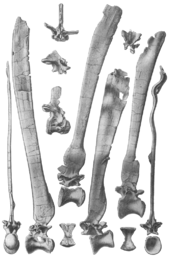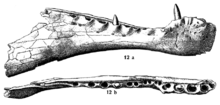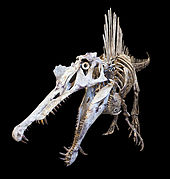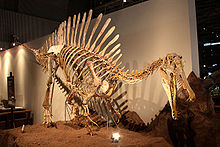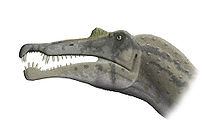
Spinosaurus
Background to the schools Wikipedia
SOS believes education gives a better chance in life to children in the developing world too. Do you want to know about sponsoring? See www.sponsorachild.org.uk
| Spinosaurus Temporal range: Early– Late Cretaceous, 112–97Ma |
|
|---|---|
 |
|
| Reconstructed skeleton of S. aegyptiacus in Chiba, Japan | |
| Scientific classification |
|
| Kingdom: | Animalia |
| Phylum: | Chordata |
| Class: | Reptilia |
| Order: | Saurischia |
| Clade: | †Megalosauria |
| Family: | †Spinosauridae |
| Subfamily: | †Spinosaurinae |
| Genus: | †Spinosaurus Stromer, 1915 |
| Type species | |
| Spinosaurus aegyptiacus Stromer, 1915 |
|
| Species | |
|
|
Spinosaurus (meaning "spine lizard") is a genus of theropod dinosaur which lived in what is now North Africa, from the lower Albian to lower Cenomanian stages of the Cretaceous period, about 112 to 97 million years ago. This genus was first known from Egyptian remains discovered in 1912 and described by German paleontologist Ernst Stromer in 1915. The original remains were destroyed in World War II, but additional material has come to light in recent years. It is unclear whether one or two species are represented in the fossils reported in the scientific literature. The best known species is S. aegyptiacus from Egypt, although a potential second species S. maroccanus has been recovered from Morocco.
Spinosaurus may be the largest of all known carnivorous dinosaurs, even larger than Tyrannosaurus and Giganotosaurus. Estimates published in 2005 and 2007 suggest that it was 12.6 to 18 metres (41 to 59 ft) in length and 7 to 20.9 tonnes (7.7 to 23.0 short tons) in weight. The skull of Spinosaurus was long and narrow like that of a modern crocodilian. Spinosaurus is thought to have eaten fish; evidence suggests that it lived both on land and in water like a modern crocodilian. The distinctive spines of Spinosaurus, which were long extensions of the vertebrae, grew to at least 1.65 meters (5.4 ft) long and were likely to have had skin connecting them, forming a sail-like structure, although some authors have suggested that the spines were covered in fat and formed a hump. Multiple functions have been put forward for this structure, including thermoregulation and display.
Description
Spinosaurus is known for its neural spines, its large size, and its elongated skull.
Size
Since its discovery, Spinosaurus has been a contender for the longest and largest theropod dinosaur. Both Friedrich von Huene in 1926 and Donald F. Glut in 1982 listed it as among the most massive theropods in their surveys, at 15 meters (49 ft) in length and upwards of 6 tons in weight. In 1988, Gregory Paul also listed it as the longest theropod at 15 meters (49 ft), but gave a lower mass estimate of 4 tonnes (4.4 short tons).
Dal Sasso et al. (2005) assumed that Spinosaurus and Suchomimus had the same body proportions in relation to their skull lengths, and thereby calculated that Spinosaurus was 16 to 18 meters (52 to 59 ft) in length and 7 to 9 tonnes (7.7 to 9.9 short tons) in weight. The Dal Sasso et al. estimates were criticized because the skull length estimate was uncertain, and (assuming that body mass increases as the cube of body length) scaling Suchomimus which was 11 meters (36 ft) long and 3.8 tonnes (4.2 short tons) in mass to the range of estimated lengths of Spinosaurus would produce an estimated body mass of 11.7 to 16.7 tonnes (12.9 to 18.4 short tons).
François Therrien and Donald Henderson, in a 2007 paper using scaling based on skull length, challenged previous estimates of the size of Spinosaurus, finding the length too great and the weight too small. Based on estimated skull lengths of 1.5 to 1.75 meters (4.9 to 5.7 ft), their estimates include a body length of 12.6 to 14.3 meters (41 to 47 ft) and a body mass of 12 to 20.9 tonnes (13 to 23.0 short tons). The lower estimates for Spinosaurus would imply that the animal was shorter and lighter than Carcharodontosaurus and Giganotosaurus. The Therrien and Henderson study has been criticized for the choice of theropods used for comparison (e.g., most of the theropods used to set the initial equations were tyrannosaurids and carnosaurs, which have a different build than spinosaurids), and for the assumption that the Spinosaurus skull could be as little as 1.5 meters (4.9 ft) in length. Improvement of the precision of size estimates for Spinosaurus requires the discovery of more complete remains as available for some other dinosaurs, especially the limb bones of Spinosaurus which are "hitherto unknown."
Neural spines
Very tall neural spines growing on the back vertebrae of Spinosaurus formed the basis of what is usually called the animal's "sail." The lengths of the neural spines reached over 10 times the diameters of the vertebral bodies from which they extended. The neural spines were slightly longer front to back at the base than higher up, and were unlike the thin rods seen in the pelycosaur finbacks Edaphosaurus and Dimetrodon, contrasting also with the thicker spines in the contemporary iguanodont Ouranosaurus.
Spinosaurus sails were unusual, although other dinosaurs, namely the ornithopod Ouranosaurus, which lived a few million years earlier in the same general region as Spinosaurus, and the South American sauropod Amargasaurus, might have developed similar structural adaptations of their vertebrae. The sail is possibly analogous (not homologous) to that of the Permian synapsid Dimetrodon, which lived before the dinosaurs even appeared; these similarities are due to parallel evolution.
The structure may also have been more hump-like than sail-like, as noted by Stromer in 1915 ("one might rather think of the existence of a large hump of fat [German: Fettbuckel], to which the [neural spines] gave internal support") and by Jack Bowman Bailey in 1997. In support of his "buffalo-back" hypothesis, Bailey argued that in Spinosaurus, Ouranosaurus, and other dinosaurs with long neural spines, the spines were relatively shorter and thicker than the spines of pelycosaurs (which were known to have sails); instead, the dinosaurs' neural spines were similar to the neural spines of extinct hump-backed mammals such as Megacerops and Bison latifrons.
Skull
The skull had a narrow snout filled with straight conical teeth that lacked serrations. There were six or seven teeth on each side of the very front of the upper jaw, in the premaxillae, and another twelve in both maxillae behind them. The second and third teeth on each side were noticeably larger than the rest of the teeth in the premaxilla, creating a space between them and the large teeth in the anterior maxilla; large teeth in the lower jaw faced this space. The very tip of the snout holding those few large anterior teeth was expanded, and a small crest was present in front of the eyes. Using the dimensions of three specimens known as MSNM V4047, UCPC-2, and BSP 1912 VIII 19, and assuming that the postorbital part of the skull of MSNM V4047 had a shape similar to the postorbital part of the skull of Irritator, Dal Sasso et al. (2005) estimated that the skull of Spinosaurus was 1.75 meters (5.7 ft) long. The Dal Sasso et al. skull length estimate was questioned because skull shapes can vary across spinosaurid species.
Classification
|
showing the position of Spinosaurus |
|||||||||||||||||||||||
|
|||||||||||||||||||||||
|
Spinosaurus gives its name to the Spinosauridae family of dinosaurs, which includes two subfamilies: Baryonychinae and Spinosaurinae. The Baryonychinae include Baryonyx from southern England and Suchomimus from Niger in central Africa. The Spinosaurinae include Spinosaurus, Irritator from Brazil, and Angaturama (which is probably synonymous with Irritator) from Brazil. The Spinosaurinae share unserrated straight teeth that are widely spaced (e.g., 12 on one side of the maxilla), as opposed to the Baryonychinae which have serrated curved teeth that are numerous (e.g., 30 on one side of the maxilla).
Discovery and naming
Naming of species
Two species of Spinosaurus have been named: Spinosaurus aegyptiacus (meaning "Egyptian spine lizard") and Spinosaurus maroccanus (meaning "Moroccan spine lizard").
The first described remains of Spinosaurus were found and described in the early 20th century. In 1912, Richard Markgraf discovered a partial skeleton of a dinosaur in the Bahariya Formation of western Egypt. In 1915, German paleontologist Ernst Stromer published an article assigning the specimen to a new genus and species Spinosaurus aegyptiacus.
Fragmentary additional remains from Bahariya, including vertebrae and hindlimb bones, were designated by Stromer as "Spinosaurus B" in 1934. Stromer considered them different enough to belong to another species, and this has been borne out. With the advantage of more expeditions and material, it appears that they pertain either to Carcharodontosaurus or to Sigilmassasaurus.
S. maroccanus was originally described by Dale Russell in 1996 as a new species based on the length of its neck vertebrae. Specifically, Russell claimed that the ratio of the length of the centrum ( body of vertebra) to the height of the posterior articular facet was 1.1 in S. aegyptiacus and 1.5 in S. maroccanus. Later authors have been split on this topic. Some authors note that the length of the vertebrae can vary from individual to individual, that the holotype specimen was destroyed and thus cannot be compared directly with the S. maroccanus specimen, and that it is unknown which cervical vertebrae the S. maroccanus specimens represent. Therefore, though some have retained the species as valid without much comment, most researchers regard S. maroccanus as a nomen dubium or as a junior synonym of S. aegyptiacus.
Specimens
Six main partial specimens of Spinosaurus have been described.
BSP 1912 VIII 19, described by Stromer in 1915 from the Bahariya Formation, was the holotype. The material consisted of the following items, most of which were incomplete: right and left dentaries and splenials from the lower jaw measuring 75 centimeters (30 in) long; a straight piece of the left maxilla that was described but not drawn; 20 teeth; 2 cervical vertebrae; 7 dorsal (trunk) vertebrae; 3 sacral vertebrae; 1 caudal vertebra; 4 thoracic ribs; and gastralia. Of the nine neural spines whose heights are given, the longest ("i," associated with a dorsal vertebra) was 1.65 meters (5.4 ft) in length. Stromer claimed that the specimen was from the early Cenomanian, approximately 97 million years ago.
This specimen was destroyed in World War II, specifically "during the night of 24/25 April 1944 in a British bombing raid of Munich" that severely damaged the building housing the Paläontologische Staatssammlung München (Bavarian State Collection of Paleontology). However, detailed drawings and descriptions of the specimen remain. Stromer's son donated Stromer's archives to the Paläontologische Staatssammlung München in 1995, and Smith et al. analyzed two photographs of the Spinosaurus holotype specimen BSP 1912 VIII 19 discovered in the archives in 2000. On the basis of a photograph of the lower jaw and a photograph of the entire specimen as mounted, Smith concluded that Stromer's original 1915 drawings were slightly inaccurate. In 2003, Oliver Rauhut suggested that Stromer's Spinosaurus holotype was a chimera, composed of vertebrae and neural spines from a carcharodontosaurid similar to Acrocanthosaurus and a dentary from Baryonyx or Suchomimus. This analysis was rejected in at least one subsequent paper.
NMC 50791, held by the Canadian Museum of Nature, is a mid-cervical vertebra which is 19.5 centimeters (7.7 in) long from the Kem Kem Beds of Morocco. It is the holotype of Spinosaurus maroccanus as described by Russell in 1996. Other specimens referred to S. maroccanus in the same paper were two other mid-cervical vertebrae (NMC 41768 and NMC 50790), an anterior dentary fragment (NMC 50832), a mid-dentary fragment (NMC 50833), and an anterior dorsal neural arch (NMC 50813). Russell stated that "only general locality information could be provided" for the specimen, and therefore it could be dated only "possibly" to the Albian.
MNHN SAM 124, owned by the Muséum National d'Histoire Naturelle, is a snout (consisting of partial premaxillae, partial maxillae, vomers, and a dentary fragment). Described by Taquet and Russell in 1998, the specimen is 13.4 to 13.6 centimeters (5.3–5.4 in) in width; no length was stated. The specimen was located in Algeria, and "is of Albian age." Taquet and Russell believed that this specimen along with a premaxilla fragment (SAM 125), two cervical vertebrae (SAM 126-127), and a dorsal neural arch (SAM 128), belonged to S. maroccanus.
BM231 (in the collection of the Office National des Mines, Tunis) was described by Buffetaut and Ouaja in 2002. It consists of a partial anterior dentary 11.5 centimetres (4.53 in) in length from an early Albian stratum of the Chenini Formation of Tunisia. The dentary fragment, which included four alveoli and two partial teeth, was "extremely similar" to existing material of S. aegyptiacus.
UCPC-2 in the University of Chicago Paleontological Collection consists mainly of two narrow connected nasals with a "fluted crest" from the region between the eyes. The specimen, which is 18.0 centimetres (7.09 in) long, was located in an early Cenomanian part of the Moroccan Kem Kem Beds in 1996 and described in the scientific literature in 2005 by Cristiano Dal Sasso of the Civic Natural History Museum in Milan and colleagues.
MSNM V4047 (in the Museo di Storia Naturale di Milano), described by Dal Sasso et al. in 2005, consists of a snout (premaxillae, partial maxillae, and partial nasals) 98.8 centimetres (38.9 in) long from the Kem Kem Beds. Like UCPC-2, it is thought to have come from the early Cenomanian.
Other known specimens consist mainly of very fragmentary remains and scattered teeth. These include:
- Possible material belonging to Spinosaurus has been reported from the Turkana Grits of Kenya.
- A 1986 paper described prismatic structures in tooth enamel from two Spinosaurus teeth from Tunisia.
- Buffetaut (1989, 1992) referred three specimens from the Institut und Museum für Geologie und Paläontologie of the University of Göttingen in Germany to Spinosaurus: a right maxilla fragment IMGP 969-1, a jaw fragment IMGP 969-2, and a tooth IMGP 969-3. These had been found in a Lower Cenomanian or Upper Albian deposit in southeastern Morocco in 1971.
- Kellner and Mader (1997) described two unserrated spinosaurid teeth from Morocco (LINHM 001 and 002) that were "highly similar" to the teeth of the S. aegyptiacus holotype.
- Teeth from the Chenini Formation in Tunisia which are "narrow, somewhat rounded in cross-section, and lack the anterior and posterior serrated edges characteristic of theropods and basal archosaurs" were assigned to Spinosaurus in 2000.
- Teeth from the Echkar Formation of Niger were "tentatively" referred to Spinosaurus in 2007.
- A partial tooth 8 cm long purchased at a fossil trade show, reportedly from the Kem Kem Bed of Morocco and attributed to Spinosaurus maroccanus, showed 1–5 mm wide longitudinal striations and micro-structures (irregular ridges) among the striations in a 2010 paper.
Paleoecology
The environment inhabited by Spinosaurus is only partially understood, and covers a great deal of what is now northern Africa. A 1996 study concluded from Moroccan fossils that Spinosaurus, Carcharodontosaurus, and Deltadromeus "ranged across north Africa during the late Cretaceous (Cenomanian)." Those Spinosaurus that lived in what is now Egypt may have contended with shoreline conditions on tidal flats and channels, living in mangrove forests alongside similarly large dinosaurian predators Bahariasaurus (which may be synonymous with Deltadromeus) and Carcharodontosaurus, the titanosaur sauropods Paralititan and Aegyptosaurus, the 10-meter (33-ft) long crocodilian Stomatosuchus, and the coelacanth Mawsonia.
Paleobiology
Function of neural spines
The function of the dinosaur's sail or hump is uncertain; scientists have proposed several hypotheses including heat regulation and display. In addition, such a prominent feature on its back could also make it appear even larger than it was, intimidating other animals.
The structure may have been used for thermoregulation. If the structure contained abundant blood vessels, the animal could have used the sail's large surface area to absorb heat. This would imply that the animal was only partly warm-blooded at best and lived in climates where nighttime temperatures were cool or low and the sky usually not cloudy. It is thought that Spinosaurus and Ouranosaurus both lived in or at the margins of an earlier version of the Sahara Desert, which could explain this. It is also possible that the structure was used to radiate excess heat from the body, rather than to collect it. Large animals, due to the relatively small ratio of surface area of their body compared to the overall volume ( Haldane's principle), face far greater problems of dissipating excess heat at higher temperatures than gaining it at lower. Sails of large dinosaurs added considerably to the skin area of their bodies, with minimum increase of volume. Furthermore, if the sail was turned away from the sun, or positioned at a 90 degree angle towards a cooling wind, the animal would quite effectively cool itself in the warm climate of Cretaceous Africa. However, Bailey (1997) was of the opinion that a sail could have absorbed more heat than it radiated. Bailey proposed instead that Spinosaurus and other dinosaurs with long neural spines had fatty humps on their backs for energy storage, insulation, and shielding from heat.
Elaborate body structures of many modern-day animals usually serve to attract members of the opposite sex during mating. It is quite possible that the sails or humps of these dinosaurs were used for courtship, in a way similar to a peacock's tail. Stromer speculated that males and females may have differed in the size of the neural spine.
Finally, it is quite possible that the sail or hump combined these functions, acting normally as a heat regulator, becoming a courting aid during the mating season, being used to cool itself and, on occasions, turning into an intimidating device when an animal was feeling threatened.
Posture
Although traditionally depicted as a biped, it has been suggested since the mid-1970s that Spinosaurus was at least an occasional quadruped. This has been bolstered by the discovery of Baryonyx, a relative with robust arms. Because of the mass of the hypothesized fatty dorsal humps of Spinosaurus, Bailey (1997) was open to the possibility of a quadrupedal posture, leading to new restorations of it as such. The hypothesis that Spinosaurus had a typical quadrupedal gait has fallen out of favour, though spinosaurids may have crouched in a quadrupedal posture. Theropods, including spinosaurids, could not pronate their hands (rotate the forearm so the palm faced the ground), but a resting position on the side of the hand was possible, as shown by fossil prints from an Early Jurassic theropod.
Feeding
It is unclear whether Spinosaurus was primarily a terrestrial predator or a piscivore, as indicated by its elongated jaws, conical teeth and raised nostrils. The hypothesis of spinosaurs as specialized fish eaters has been suggested before by A. J. Charig and A. C. Milner for Baryonyx. They base this on the anatomical similarity with crocodilians and the presence of digestive acid-etched fish scales in the rib cage of the type specimen. Large fish are known from the faunas containing other spinosaurids, including the Mawsonia, in the mid-Cretaceous of northern Africa and Brazil. The only direct evidence for spinosaur diet comes from related European and South American taxa. Baryonyx was found with fish scales and bones from juvenile Iguanodon in its stomach, while a tooth embedded in a South American pterosaur bone suggests that spinosaurs occasionally preyed on pterosaurs. Spinosaurus was likely to have been a generalized and opportunistic predator, possibly a Cretaceous equivalent of large grizzly bears, being biased toward fishing, though it undoubtedly scavenged and took many kinds of small or medium-sized prey.
In 2009, Dal Sasso et al. reported the results of X-ray computed tomography of the MSNM V4047 snout. As the foramina on the outside all communicated with a space on the inside of the snout, the authors speculated that Spinosaurus had pressure receptors inside the space that allowed it to hold its snout at the surface of the water to detect swimming prey species without seeing them.
A 2010 isotope analysis by Romain Amiot and colleagues found that oxygen isotope ratios of spinosaurid teeth, including teeth of Spinosaurus, indicate semiaquatic lifestyles. Isotope ratios from tooth enamel and from other parts of Spinosaurus (found in Morocco and Tunisia) and of other predators from the same area such as Carcharodontosaurus were compared with isotopic compositions from contemporaneous theropods, turtles, and crocodilians. The study found that Spinosaurus teeth from five of six sampled localities had oxygen isotope ratios closer to those of turtles and crocodilians when compared with other theropod teeth from the same localities. The authors postulated that Spinosaurus switched between terrestrial and aquatic habitats to compete for food with large crocodilians and other large theropods respectively.
In popular culture
Spinosaurus appeared prominently in the 2001 film Jurassic Park III. The film's consulting paleontologist John R. Horner was quoted as saying: "If we base the ferocious factor on the length of the animal, there was nothing that ever lived on this planet that could match this creature [Spinosaurus]. Also my hypothesis is that T-rex was actually a scavenger rather than a killer. Spinosaurus was really the predatory animal." In the film, Spinosaurus was portrayed as larger and more powerful than Tyrannosaurus: in a scene depicting a battle between the two resurrected predators, Spinosaurus emerges victorious by snapping the tyrannosaur's neck.
Spinosaurus has long been depicted in popular books about dinosaurs, although only recently has there been enough information about spinosaurids for an accurate depiction. After an influential 1955 skeletal reconstruction by Lapparent and Lavocat based on a 1936 diagram by Stromer, it has been treated as a generalized upright theropod, with a skull similar to that of other large theropods and a sail on its back, even having four-fingered hands.
In addition to films, action figures, video games, and books, Spinosaurus has been depicted on postage stamps such as ones from Angola, The Gambia, and Tanzania.
The creature has also appeared in documentaries such as Bizarre Dinosaurs, Monsters Resurrected and Planet Dinosaur.


